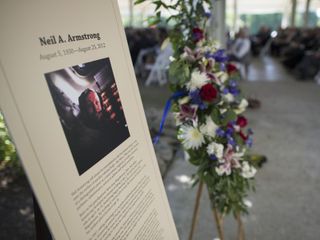Neil Armstrong Public Memorial Service to Celebrate Life of 1st Moonwalker

The last man to leave his bootprints on the moon will pay tribute to the first man who laid foot there at a national memorial service for the late astronaut Neil Armstrong.
Eugene Cernan, who followed in Armstrong's 'small steps' as the 12th and last American astronaut to stand on the lunar surface, will join NASA Administrator Charles Bolden and the former Secretary of the Treasury John W. Snow at the Washington National Cathedral on Thursday (Sept. 13) to deliver remarks celebrating Neil Armstrong, commander of the Apollo 11 mission.
Armstrong, 82, died Aug. 25 following complications that resulted from cardiovascular procedures. In July 1969, he spoke the instantly historic words, "That's one small step for (a) man, one giant leap for mankind" as he became the first human to walk on the moon.
Thursday's public memorial in Washington, D.C., precedes Armstrong's burial at sea, to be conducted by the Navy on Friday. Details of his ocean interment were not released, though President Barack Obama ordered flags be flown at half-mast to mark the day of the ceremony.
Mourning the first moonwalker
The memorial service at the cathedral, for which a limited number of seats were reserved for the public to attend, will bring together dignitaries, community and political leaders, Armstrong's family members, and members of the NASA family, including current and former astronauts, to mourn the loss of the first moonwalker. [Photos: Astronaut Icon Neil Armstrong Remembered]
Armstrong's Apollo 11 crewmate, Michael Collins, will lead the assembly in prayers.
Get the Space.com Newsletter
Breaking space news, the latest updates on rocket launches, skywatching events and more!
In July 1974, Collins, Neil Armstrong and Buzz Aldrin donated one of the moon rocks they brought back to Earth to the National Cathedral. A sliver of that same lunar rock is now on display there, embedded in a stained glass window that pays tribute to their historic moon landing.
In between the tributes and readings, the latter to include a biblical passage read by former Secretary of the Navy John Dalton, musicians will dedicate performances to the late Armstrong. Canadian jazz pianist Diana Krall will sing "Fly Me to the Moon" as arranged by Frank Sinatra.
The Metropolitan Opera Brass, the U.S. Navy Band "Sea Chanters," and the Cathedral Choristers will also perform pieces, including "America the Beautiful."
The ceremony will close with Bolden's presentation of an American flag to Carol Armstrong, the astronaut's widow. The U.S. flag was flown over the Mission Control Center at NASA's Johnson Space Center in Houston on the day of Armstrong's passing.

Public tribute
For those unable to be there, NASA will air the memorial service live on its television channel as well as stream it online through its website.
Armstrong's family earlier gathered for a private service on Aug. 31 in Cincinnati, Ohio. The family also established the "Neil Armstrong New Frontiers Initiative," a memorial fund for the Cincinnati Children's Hospital Medical Center.
They have asked that memorials be made to the Initiative, or to two scholarship funds setup in Armstrong's name by the Telluride Foundation and by the American Institute of Aeronautics and Astronautics (AIAA).
The family also suggested for those wishing to pay tribute, that they "honor his example of service, accomplishment and modesty, and the next time you walk outside on a clear night and see the moon smiling down at you, think of Neil Armstrong and give him a wink."
Follow collectSPACE on Facebook and Twitter @collectSPACE and editor Robert Pearlman @robertpearlman. Copyright 2012 collectSPACE.com. All rights reserved.
Join our Space Forums to keep talking space on the latest missions, night sky and more! And if you have a news tip, correction or comment, let us know at: community@space.com.

Robert Pearlman is a space historian, journalist and the founder and editor of collectSPACE.com, an online publication and community devoted to space history with a particular focus on how and where space exploration intersects with pop culture. Pearlman is also a contributing writer for Space.com and co-author of "Space Stations: The Art, Science, and Reality of Working in Space” published by Smithsonian Books in 2018. He previously developed online content for the National Space Society and Apollo 11 moonwalker Buzz Aldrin, helped establish the space tourism company Space Adventures and currently serves on the History Committee of the American Astronautical Society, the advisory committee for The Mars Generation and leadership board of For All Moonkind. In 2009, he was inducted into the U.S. Space Camp Hall of Fame in Huntsville, Alabama. In 2021, he was honored by the American Astronautical Society with the Ordway Award for Sustained Excellence in Spaceflight History.

